In life, there are journeys that lead you not across physical distances but through the realms of your own being. My experience of Vipassana meditation was one such transformative odyssey.
Contents
What is Vipassana
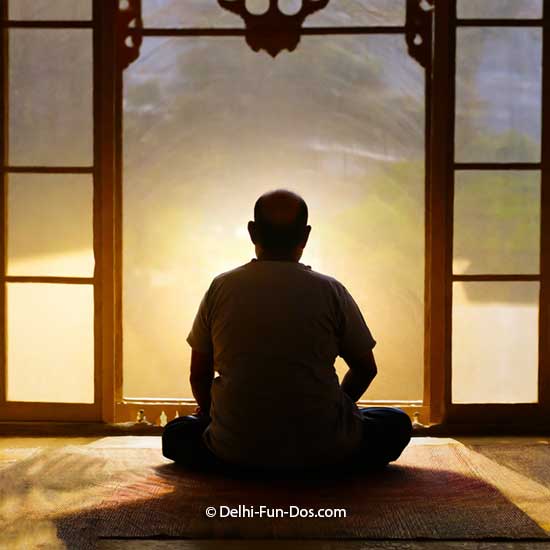
In the ancient language of Buddhism called Pali, the term “Vipassana” translates to “seeing things as they really are. “Vipassana meditation” is like “mindfulness meditation” but not exactly that. It is more specific with its special rules and format. Vipassana is pronounced as Bi-Pa-Shya-na in Hindi/Sanskrit and Paali.
Why Vipassana
I was going through a phase in my life. The storm passed but I was still shaken and that’s when one of my friends recommended doing the Vipassana course – A silent retreat of 10 days. Intrigued, I registered for the course, unaware that it would mark the beginning of a profound internal journey. This was in 2009, before my days as a travel blogger, before the inception of our blog DelhiFunDos. With some time on my hands, I decided to seize the opportunity to disappear for 10 days into the world of Vipassana.
Sign Up for the Vipassana Meditation Course
I explored the official Vipassana meditation site at Dhamma.org and enrolled in a 10-day Vipassana course. My scheduled course date was approximately one and a half months later. Immersing myself in the details of the course, I learned that it was entirely free of cost and offered in multiple languages. Participants had the flexibility to select any Vipassana center from a list of options in India and abroad. The commitment involved a ten-day period of complete withdrawal from external communication, adhering to a vow of silence (Maun Vrat), consuming only the meals provided at the meditation center, and diligently following the guidance of the assistant teachers. I received warnings about the rigorous nature of the course, with stories of many participants abandoning it midway. Driven by a penchant for challenging tasks, I embraced the opportunity.
Centres for Vipassana Course
Despite Sohna in Gurgaon being the closest Vipassana center for Delhi residents, I intentionally selected Dharamkot near Dharmshala in Himachal Pradesh. The desire to escape Delhi for a while motivated my choice. It was my first time visiting Dharmshala, and during those days (back in August 2009), it lacked the crowded touristy vibe that defines it today.
The Vipassana Centre at Dharamkot
The anticipation grew as the course date approached. Finally, the day arrived, and armed with all the information I could gather about the course, I boarded an HPTDC bus to Dharmshala. This was the only solo trip I have taken to date.
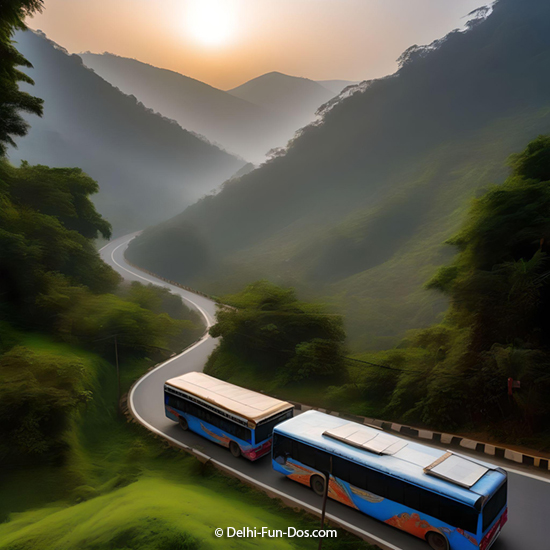
The Vipassana meditation center in Dharamkot, nestled amidst lush greenery, welcomed me with the fragrance of recent rain. Upon reaching the center, a sense of solitude engulfed me as I encountered an empty space. Doubt crept in, questioning whether I had indeed arrived at the correct Vipassana center, considering Dharmshala’s abundance of meditation centers. My uncertainty dissipated when another Vipassana participant, a foreign national whose specific country I can’t recall now, approached. With folded hands, she greeted me with a Namaste. With the greenery, fresh air, and pin-drop silence of this area, it felt like my meditation course had already started.
Also Read: Travel Tips for Dharmashala and McLeodganj
Out of nowhere, a representative from the meditation center came and explained that the commencement of the course would take some time. Recognizing my fatigue from the overnight journey, he kindly offered to arrange a bed for me to rest. Grateful for the offer, I agreed, and he guided me to a nearby tent, where I found a wooden bed with thin bedding and a pillow. Quickly succumbing to tiredness, I lay down and drifted into a deep sleep.
Upon hearing some distant noises, I came out of my tent to discover a bustling center filled with numerous participants. It seemed I had dozed off for a few hours, and in that time, many fellow Vipassana course attendees had arrived.
Renouncing Possessions – The Vipassana Essentials
I was asked to go to a designated window to receive my room assignment. Joining a queue, I patiently awaited my turn. When called, I underwent the ritual of renouncing all personal belongings – food, gadgets, writing materials, cash, and wallet, etc. for the next 10 days. My possessions were securely stored in a locker, and I was given a token.
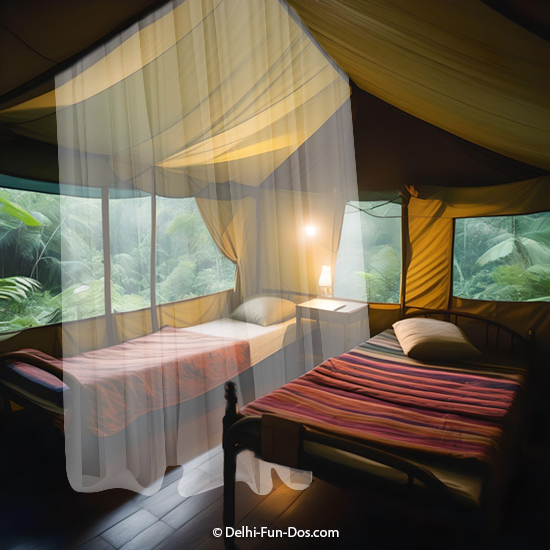
I was assigned a tented dorm accommodated with around 18 to 20 beds, and my designated area was shared with another person, separated by a thin curtain.
The Vipassana Meditation Course
We were called for lunch in the dining hall. We were told some rules of the Vipassana mediation. Every day they would wake us up at 4 in the morning. 4.30 all the Vipassana practitioners were to gather in the main mediation hall for mediation that went on for a couple of hours. Men and women had separate lodging areas. In the mediation hall, men and women meditated together but in dedicated sections.
After that, there would be breakfast. Post breakfast one was to meditate again for a few hours. One can do that in the meditation hall or in their rooms/dorms on their bed. 11 am was the lunch hour and there was a break after that.
In the evening everyone gathered in the main mediation hall and they had a discourse by Mr. Goenka who is credited for bringing Vipassana back to India from Burma. The course was open to everyone irrespective of their religion, country, or ethnicity. There were separate halls for people who wanted the discourse in a non-English language where they got translated discourse in their preferred language on headphones.
My First Three Days at Vipassana
The initial days at the Vipassana Meditation Centre were really tough for me. Sleeping in a tent on a somewhat hard bed was challenging. Every day at 4 in the morning, a soft sound of handbells would ring outside the tent as assistants signalled the start of the day. They didn’t wake anyone up individually; instead, they continued ringing until everyone was out of their beds. Some participants headed straight to the meditation hall. I followed my routine of showering in the common bathrooms and then made my way to the meditation hall. They had geysers but sometimes the water would get cold as many people showered around that time one after the other. Sometimes I would shower with cold water just to wake myself up fully.

Dharamkot was dark, foggy, and chilly at that early hour. The path from the tent to the meditation hall was uphill, illuminated by lanterns, creating a magical atmosphere. It felt surreal for me, a city person engrossed in my life, family and my small business in Delhi, to suddenly find myself in this unusual meditation centre doing this bizarre routine of meditation at such an early hour of the day.
It practically rained every day in Dharamkot during my 10-day stay at the meditation centre. There were nights when the loud rumble of thunder woke me up, prompting me to go outside my tent to investigate. The darkness was so intense that my only glimpse of the rain was through the illumination of a lamppost in the center of the tented area. Once again it all felt so surreal.
Sometimes, I would doze off during group meditation sessions or while meditating in my dorm, leaving me feeling guilty. In the initial days, we practised Anapana, focusing on the inhale and exhale of breathing. Unfortunately, I struggled to concentrate and didn’t find it particularly therapeutic. Concluding that meditation might not be suitable for me, I contemplated leaving the course.
The Transformation Begun
Every day, there was a half-hour time slot where you could talk to the assistant teachers if needed, although generally, talking was discouraged throughout the course. On the third day, I approached the assistant teacher and expressed my desire to leave the course, explaining that it wasn’t working for me. Many people left for various reasons, like the silence, limited food, or the demanding meditation sessions. However, my struggle was unique – I wanted to quit because I couldn’t concentrate on meditation; my mind was scattered and distracted.
The assistant teacher acknowledged that the third day was often the most challenging for many practitioners and encouraged me to hang in a bit longer. He suggested waiting until the evening discourse, and even after that, if I still wanted to leave, they would return my belongings and allow me to go. He mentioned that having ten consecutive days free in life was rare. Now that I was there, I should complete the course. Reflecting on it, i felt he was right. Over the years, I couldn’t recall having ten days off for anything. Despite my initial struggles, I decided to stay on until the evening discourse.
I can’t recall the specifics of what I heard during the discourse, but something at that moment made me commit to completing my Vipassana course. From that point on, not once did I think of giving up during the remaining seven days.
Food at Vipassana Centre
Our morning breakfast, at 7, included a variety of items such as milk, bread, poha, upma, and occasionally, delightful homemade peanut butter. Lunch, scheduled for 11, featured simple and comforting Indian dishes-mixed vegetables, daal, salad, and tawa chapatis. During lunch on the fifth or sixth day, a mildly sweet coconut laddoo was added as a sweet surprise. Oh, the simple pleasures of life!!! We would wash our utensils after every meal.
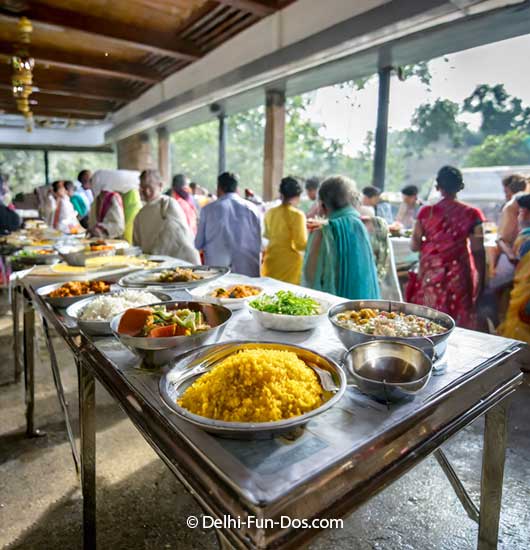
Most of the days they had herbal tea placed in a steel container outside the dining hall. We were allowed to have it freely during our breaks from meditation. Our evening tea at 4, was sometimes accompanied by roasted murmura and peanut mixture, and other times with bananas.
That was it for the day. There was no dinner!!
How to Communicate During Vipassana
Not just verbal but all sorts of communication was prohibited during the 10 days of the Vipassana meditation course. This included abstaining from using gestures as a means of communication. A steel tumbler with a pen and small paper chits was provided for essential written communication on one side of the dining hall. I needed an extra blanket as I used to feel cold at night. I wrote on a chit with my bed number and dropped it in the tumbler. Returning from my meditation session in the hall that evening, I discovered an additional blanket neatly placed on my bed. The subtle gesture of care touched me deeply, emphasising the silent but profound connection fostered within the course’s unique communication restrictions.
In between Vipassana Meditation
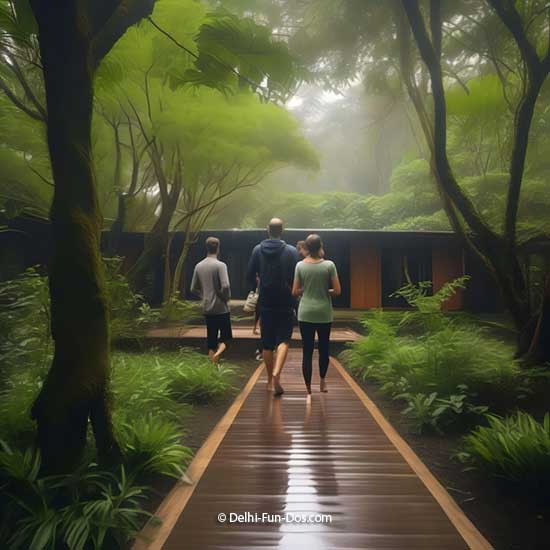
All sorts of physical exercise and other forms of meditation were also prohibited during Vipassana. During the breaks, individuals had the opportunity to take strolls within the meditation centre. The approximately 400-meter pathway encircling the meditation centre became my haven, where I would walk and immerse myself in the lush greenery. Sometimes, I would simply sit, allowing moments of introspection. On occasions, a rush of emotions would overcome me, manifesting as tears, an emotional detox, I presumed.
I would often observe snails slowly making their way across the pathway. I found a sense of calm and the urge to slow down looking at the pace of the snail. While walking, glimpses of cars and trucks on the downhill road would momentarily remind me of the life I temporarily left behind for those ten days. It felt as though I had entered a different world for a brief period.
The Essence of Vipassana Meditation

True Vipassana practice unfolded after the third day. The course introduced advanced meditation techniques that, in retrospect, emphasised the essence of being present and recognizing the perpetual change in life. Every moment, every nanosecond, our bodies undergo degeneration – a natural design where nothing remains permanent. This realisation prompts the question: why dwell on past sorrows? Nothing in life is permanent.
While Vipassana meditation originated in India, it gradually faded over the years. Fortunately, the practice endured in Burma. Mr. Goenka, an Indian-origin man, played a pivotal role in reintroducing Vipassana from Burma to India. Although he is no longer with us, his recorded discourses were available and played every evening in the main hall. During these sessions, he would chant mantras, presumably in Pali language. Although I couldn’t understand a word, they had a therapeutic and calming effect on me. In the blink of an eye, my ten days at the meditation centre passed by.
How Vipassana Course is Sustained Without Any Fee
Throughout the course, no one solicited money or favours from the participants. On a particular day, the concept of Dana (giving) was introduced, shedding light on the centre’s operational philosophy. The centre relied solely on donations, and none of the practitioners were charged for the course. The underlying principle was to emulate the lifestyle of a monk, who sustained themselves on alms. This approach eliminated the sense of pride (ahankar) associated with paying for services.
Participants were encouraged to contribute through Dana voluntarily. The act of giving was entirely optional, and I cannot recall anyone approaching me or others, seeking donations during the course. The system operated on trust and the willingness of individuals to offer support if they so desired.
And Then We Spoke – the Last Day of Vipassana Meditation
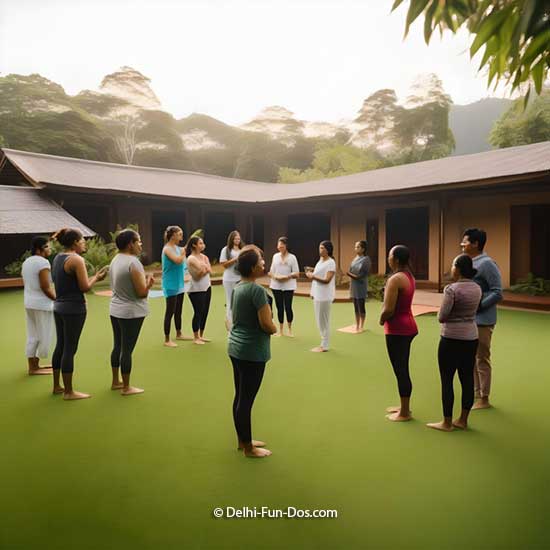
On the concluding day, we regained our right to speak and engaged in conversations, exchanging pleasantries and sharing our Vipassana meditation experiences. It was the first time in 10 days that I spoke to my room partner, Adam, who hailed from the UK. Reflecting on the course, I wasn’t entirely certain what I had gained or if I had been healed. But I felt a plain sense of happiness for completing it, thanks to the guidance of the assistant teachers at the Vipassana centre.
After bidding farewell to fellow participants and receiving our belongings, I descended from the centre and headed to a nearby German bakery. Craving something more indulgent after ten days of simple fare, I ordered a honey lemon ginger tea with a delectable jam roll and potato chips.
The life Beckons
I opted for a shared jeep to reach Dharmshala. The afternoon was spent in the comfort of a hotel bed. I explored the McLeod Ganj market and visited the Dalai Lama temple, and as evening approached, I packed my belongings before starting on my overnight bus journey back to Delhi.
Several years have passed since I completed my Vipassana meditation course. Contrary to my misguided expectation of an immediate magical transformation to heal my pain, the transformation occurred gradually over time, subtly and without my conscious awareness. Reflecting on it now, I find myself in a significantly better and happier place. Would I recommend Vipassana to others? Certainly. Especially if you find yourself at a crossroads in life, give it a shot. However, approach Vipassana without any specific expectations- immerse yourself in the experience, something truly unique and a once-in-a-lifetime opportunity.
Disclaimer: Since photography was not allowed, we have created all the pictures used in this blog using AI.




Wow, this sounds like such an amazing experience. It would definitely be hard to find 10 days that I could be gone, though, with two young kids to take care of. I think the hardest for me would be not having a say in food since I have so many allergies but I’m assuming they take that into consideration for participants.
For a long time I’ve wanted to take my meditation practice to the next level. Would be wonderful to attend this course.
Oh wow, this sounds amazing! I’ve never heard of Vipassana meditation but I’d love to go on a retreat and try it.
I need to start meditating. I’m so stressed all the time, and vipassana mediation sounds like it would be a big help.
The Vipassana sounds interesting. I have been on a couple yoga and meditation tours and I know how beneficial it is. Thank you for sharing about the Vipassana center.
Very cool, seems interesting journey, and would love to try this as I’m into meditation a lot.
It is my first time to hear about Vipassana Meditation and it sounds really interesting. I will definitely read more about it.
Such a beautiful place and I thank you for sharing your experience. Hope I get to experience this as well at some point in my life.
Although I am not the biggest fan of meditation this course looks really interesting, and demanding. Thanks for sharing.
It’s amazing how the most transformative things in life happen so subtly and gradually, without us even realising it. Your reflection on your Vipassana experience is inspiring and I’m glad to hear that it has brought you to a better and happier place. Your recommendation to approach Vipassana without any specific expectations and to immerse oneself in the experience is a valuable reminder for anyone interested in trying it out. It truly is a unique and once-in-a-lifetime opportunity that should be approached with an open mind and heart.